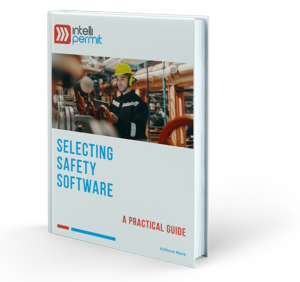A Winning Start to your Permit To Work Project
A permit to work system touches many departments; production, safety, maintenance, people and information technology. Getting all of these stakeholders aligned to a common goal is essential for a successful implementation of IntelliPERMIT. Building the right team at the start and helping each individual to work across the disciplines is a key success factor. This requires effective leadership of the project team and a clear link of the project goals to the business objective of ensuring work always takes place safely.
What criteria do you use to measure the success of your process improvement initiatives? Typically, these projects are granted a budget and a timeline to complete a scope of work – so the temptation for everybody involved is to simply focus on getting these boxes ticked, declare success and head for the celebratory lunch.
Have we measured the actual impact to the business? Will the improvements survive the departure of key project sponsors? Have we laid a platform for continuous improvement?
In over 15 years of implementing Adapt IT’s computerised permit to work system, IntelliPERMIT, across a wide range of industries and operating environments, patterns have emerged that clearly separate the standout accomplishments from projects that “ticked the boxes” but failed to meet the broader definition of success. As one would expect, a number of the success factors could be recited directly from any playbook on project management best practice. However, there are a few critical success factors that are worth dwelling on.
A great start
Exceptional projects are constructed on solid foundations. Generally it is not hard to identify the correct stakeholders; define the roles; allocate resources; assign tasks and set deadlines. But do we truly have a shared vision for the project? Is this vision aligned to the broader company strategy? If not, the project may not survive the inevitable challenges that will arise: key stakeholders leave, budgets are cut, and other priorities are pushed forward.
One way to test the shared vision is to simply ask the participants what they expect to personally get out of the project –and what they believe that they can contribute towards its success.Too many diverging personal objectives can be a warning sign that the project will stutter under pressure, and that more time needs to be spent clarifying and communicating the project objectives.
Asking the right questions
It is important that enough time is spent ensuring that the problem is correctly framed, before “the” solution is proposed. Be prepared to take on-board some of the bad news that may emerge from this process: there might be fundamental risks in the permit to work and isolation procedures that need resolution before we set about simply improving their efficiency with a computerised system. Conversely, are the challenges being experienced in fact best addressed by enforcing the discipline of a system like IntelliPERMIT? In the system roles must be clearly defined and allocated to competent and authorised persons before permits can be signed. In this case, implementing the system is a powerful catalyst for change because compliance is forced, and the project has to ensure that the processes for capturing and maintaining this data are efficient and accurate – something that may not have been a priority before.
Measure progress towards goals
How are you going to measure the impact of the project on the business? Did the project deliver the value promised? You may have some data that can form the basis of before and after comparisons – a common example being trends derived from planned task observations on isolation breaches. While useful, be aware that these metrics should be derived from a statistically significant sample, and be truly comparable before and after.The measures need not be absolutely precise, but consistent and accurate enough to indicate trends.
Since individual metrics may be too narrowly defined and prone to changes in how the data is collected, consider broader measures that capture the overall health of the business process. What is the “total cost of safety” during a shutdown relative to the total cost of the shutdown? This would be the total time and resources spent on isolating and de-isolating the plant, co-ordinating permits to work, supervising work crews, plus the cost of incidents and lost production if the process fails? Tracking this broad metric allows for better decisions on where to invest in the process: maybe we need to spend more time preparing task or equipment-specific isolation procedures? How much time is wasted on scope changes once the planning is at an advanced stage? How many permits are prepared and the plant isolated, only for the work to be de-scoped? Could we improve the overall efficiency of the process by cutting back on the scope during planning phase?
Help from the people who have been there and got the T-shirt
You will find that that there is an active community of users who are only too keen to contribute their experience towards the success of your project. They are justifiably proud of what they have achieved and learnt. Yes, their operational environment may be different; their problems and objectives may be dissimilar; and the particular technical challenges they encountered could be unique. But all projects involve a process of change for the people affected. How were these people engaged to feel part of the project? What fears did people express and how were these addressed?
Don’t overlook the input these people can provide on better estimates for phases such as collecting data, testing the configuration, and training users. This knowledge is extremely useful in constructing an evidence-based plan that does not depend on heroics to meet unrealistic deadlines.
Developing your people
Our repeated experience is that selecting the right people to drive the implementation of IntelliPERMIT is critical for project success. However, it is rare that we find individuals who already possess the complete package of skills necessary.
“Use projects to build the skills of people technically, in leadership, and most of all, to inspire people to be their best selves” [Building the Mindset for Exceptional Leadership, Alan Willett]Recognise that implementing a new permit to work system is a tremendous opportunity to develop people in your organisation. IntelliPERMIT sits at the intersection between production, safety, maintenance, training and IT; it has a crucial role to play in the most complex and intense shutdowns; it controls the fundamental transactions between multiple work teams with potential for serious injuries arising from their interactions. Working in this space forces the people involved to understand multiple perspectives on the business. Taking people into zones of learning adjacent to their current competency is an ideal situation to their broaden skills and grow the overall human capacity available to the business. Most importantly, these are the people best positioned to drive continuous improvement once the project is handed over to operations.
Article by Scott Bredin
Free Guide - Selecting Safety Software

Learn why safety management software is necessary to support a modern industrial operation, the different types of software applications, and helpful, practical advice on how to undertake a safety software selection process in your own company.
Get started today, download your guide and take the next step towards world-class safety management.
Our repeated experience is that selecting the right people to drive the implementation of IntelliPERMIT is critical for project success. However, it is rare that we find individuals who already possess the complete package of skills necessary.
Taking people into zones of learning adjacent to their current competency is an ideal situation to their broaden skills and grow the overall human capacity available to the business

Continue Reading
Q&A with IntelliPERMIT Consultant Lungelo Majozi
Explore the advantages of electronic permit to work (e-PTW) systems over paper methods, from faster investigations to specific hazard management. Learn how e-PTW enhances safety, prevents redundant isolations, and ensures accountability. Discover future trends like 3D modeling. IntelliPERMIT automates tasks, improves communication, and reduces costs, making workplaces safer and more efficient.
Powering Safety Innovations: An Exclusive Q&A with IntelliPERMIT Consultant Shirley Breytenbach
IntelliPERMIT transforms permit management with streamlined processes, competency-based approvals, and real-time visibility. Ensure regulatory compliance, enhance worker safety, and boost operational efficiency. The system offers seamless integration, empowering organisations to proactively mitigate safety risks.
Safety Software Implementation Success : An Exclusive Q&A with IntelliPERMIT Consultant Henry Boshoff
Unlock safety software success with IntelliPERMIT: Prioritise key features, secure user buy-in through change management, and foster collaboration. Set measurable goals, leverage incident data for proactive decisions, and ensure intuitive search capabilities. Streamline report generation and simplify scheduling and management of training, drills, toolbox talks, and audits. Overcome adoption challenges by addressing pain points and customizing the software. Enhance user adoption with automation and user-friendly interfaces. Evaluate safety software providers based on knowledge, experience, and adherence to standards—IntelliPERMIT excels. Easily integrate with existing systems through standard APIs. Opt for web-based software for accessibility and usability. IntelliPERMIT enhances safety practices and compliance.



